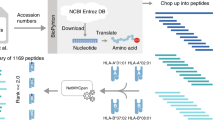Abstract
We have previously described several complementary DNA clones isolated because they correspond to messenger RNAs present at higher levels in the simian virus 40 (SV40)-transformed BALB/c 3T3 cell line SV3T3 Cl38 than in the normal, parental BALB/c 3T3 line1. One of these clones, pAG64, hybridizes to RNAs which, while present in BALB/c 3T3 cells, are 10–20-fold more abundant in SV3T3 Cl38 and are found at high levels in a wide variety of transformed cell lines1,2. Nucleotide sequence analysis showed that pAG64 encodes a class I antigen of the major histocompatibility complex2. To ascertain the identity of pAG64, we compared its sequence with the available sequences of d haplotype class I antigen genes [K locus3, L locus4, D locus5 and the Qa gene defined by genomic clone 27.1 (ref. 6)] and found that it showed multiple clustered differences from each of these sequences2. We therefore concluded that it was not derived from the H–2Kd, H–2Ld or H–2Dd genes and thus must correspond to one of the other class I antigen genes, namely those of the Qa/Tla complex2, although it was clearly not the Qa gene defined by the genomic clone 27.1. We now report subsequent findings which indicate that pAG64 in fact corresponds to the H–2Dd gene and not to a Qa/Tla gene.
This is a preview of subscription content, access via your institution
Access options
Subscribe to this journal
Receive 51 print issues and online access
$199.00 per year
only $3.90 per issue
Buy this article
- Purchase on Springer Link
- Instant access to full article PDF
Prices may be subject to local taxes which are calculated during checkout
Similar content being viewed by others
References
Scott, M. R. D., Westphal, K.-H & Rigby, P. W. J. Cell 34, 557–567 (1983).
Brickell, P. M., Latchman, D. S., Murphy, D., Willison, K. & Rigby, P. W. J. Nature 306, 756–760 (1983).
Lalanne, J. L. et al. Nucleic Acids Res. 10, 1039–1049 (1982).
Moore, K. W., Sher, B. T., Sun, Y. H., Eakle, K. A. & Hood, L. Science 215, 679–682 (1982).
Margulies, D. H. et al. J. Immun. 130, 463–470 (1983).
Steinmetz, M. et al. Cell 25, 683–692 (1981).
Steinmetz, M., Winoto, A., Minard, K. & Hood, L. Cell 28, 489–498 (1982).
Sher, B. T., Nairn, R., Coligan, J. E. & Hood, L. E. Proc. natn. Acad. Sci. U.S.A. 82, 1175–1179 (1985).
Margulies, D. H. et al. J. Immun. (in the press).
Favoloro, J., Treisman, R. & Kamen, R. Meth. Enzym. 65, 718–749 (1980).
Chirgwin, J. M., Przyoyla, A. E., MacDonald, R. J. & Rutter, W. J. Biochemistry 18, 5294–5299 (1979).
Majello, B., La Mantia, G., Simeone, A., Boncinelli, E. & Lania, L. Nature 314, 457–459 (1985).
Rosenthal, A. et al. Nature 315, 579–581 (1985).
Rigby, P. W. J., La Thangue, N. B., Murphy, D. & Skene, B. I. Proc. R. Soc. (in the press).
Author information
Authors and Affiliations
Rights and permissions
About this article
Cite this article
Brickell, P., Latchman, D., Murphy, D. et al. The class I major histocompatibility antigen gene activated in a line of SV40-transformed mouse cells is H–2Dd, not Qa/Tla. Nature 316, 162–163 (1985). https://doi.org/10.1038/316162a0
Issue Date:
DOI: https://doi.org/10.1038/316162a0
This article is cited by
-
Physical mapping of theE/C andgrc regions of the rat major histocompatibility complex
Immunogenetics (1996)
-
Nucleotide sequence and structural analysis of the rat RT1.E u and RT1.Aw3 l genes, and of genes related to RT1.O and RT1.C
Immunogenetics (1995)
-
Multiple TL-like loci in the grc-G/C region of the rat
Immunogenetics (1994)
-
Physical mapping of the MHC and grc by the pulse field electrophoresis
Immunogenetics (1992)
-
TheRT1.G locus in the rat encodes a Qa/TL-like antigen
Immunogenetics (1989)
Comments
By submitting a comment you agree to abide by our Terms and Community Guidelines. If you find something abusive or that does not comply with our terms or guidelines please flag it as inappropriate.



